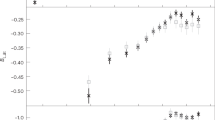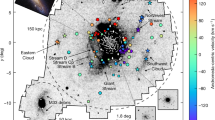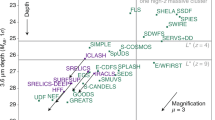Abstract
THE question of the distances of quasi-stellar objects may be dealt with on the basis of The following statistical consideration. Consider a multitude of objects of some sort, distributed according to Poisson's law in an infinite space. The mean density of these objects is D. There is an observer, whose position is chosen randomly, and the objects have been enumerated in order of increasing distance from this observer. The distance of the kth object from the observer is denoted by rk. Designating the volume of the sphere of radius rk by Vk it can be shown easily1,2 that the mean value of Vk is equal to  Each of the values
Each of the values  can be considered as “density determined by means of the xth object”. It can be shown that the dispersion of Dk decreases when k increases. The values of Dk determined using the distances of several neighbours can serve as different approximations to the mean density D.
can be considered as “density determined by means of the xth object”. It can be shown that the dispersion of Dk decreases when k increases. The values of Dk determined using the distances of several neighbours can serve as different approximations to the mean density D.
This is a preview of subscription content, access via your institution
Access options
Subscribe to this journal
Receive 51 print issues and online access
$199.00 per year
only $3.90 per issue
Buy this article
- Purchase on Springer Link
- Instant access to full article PDF
Prices may be subject to local taxes which are calculated during checkout
Similar content being viewed by others
References
Arakelian, M. A., Doklady Acad. Sciences USSR, 179, 555 (1968).
Arakelian, M. A., Astrophysika, 4 (in the press, 1968).
Schmidt, M., Ap. J., 151, 393 (1968).
Roeder, R. C., and McVittie, G. C., Ap. J., 138, 899 (1963).
Barbieri, C., Battistini, P., and Nasi, E., Publicazioni dell'Osservatorio Astronomico di Padova, No.141 (1967).
Cannon, R. D., Penston, M. V., and Penston, M. J., Nature, 217, 340 (1968).
Author information
Authors and Affiliations
Rights and permissions
About this article
Cite this article
ARAKELIAN, M. Distances, Space Distribution and Luminosity Function of Quasi-stellar Objects. Nature 219, 595–597 (1968). https://doi.org/10.1038/219595b0
Received:
Issue Date:
DOI: https://doi.org/10.1038/219595b0
This article is cited by
-
The spatial distribution and luminosity function for quasistellar radio sources
Astrophysics (1973)
-
Evolutionary effects associated with quasi-stellar radio sources. I
Astrophysics (1971)
Comments
By submitting a comment you agree to abide by our Terms and Community Guidelines. If you find something abusive or that does not comply with our terms or guidelines please flag it as inappropriate.



